The Google Nexus 9 Review
by Joshua Ho & Ryan Smith on February 4, 2015 8:00 AM EST- Posted in
- Tablets
- HTC
- Project Denver
- Android
- Mobile
- NVIDIA
- Nexus 9
- Lollipop
- Android 5.0
Battery Life
It goes without saying that battery life is one of the most important aspects of a mobile device. After all, a mobile device isn’t really mobile if it can only be used for an hour before running out of battery. In order to test this, we turn to our standard suite of battery life tests, which include our web browser battery life test, along with some compute-bound benchmarks to characterize battery life across various use cases.
However, as the Nexus 9 introduces such a unique CPU architecture, I felt that it was necessary to try and adequately capture the full extent of battery life. To this end, I’ve introduced a new test that is really quite simple but important, as we can start to separate display power from everything else since it can often be the single largest consumer of power in a test. In order to do this, everything that could run during a test is disabled, and the device is placed in airplane mode with the display at 200 nits. A white image is displayed on the screen from a full charge until the device shuts down.
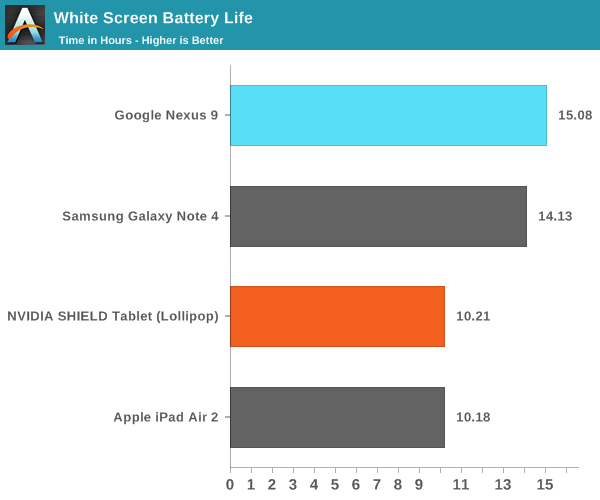
Interestingly enough, the display runtime on the Nexus 9 is about as good as it gets when compared to other devices for which we have data. I suspect we’re looking at the direct result of the large battery combined with an efficient display, as the Nexus 9 can last as long as 15 hours in this test compared to the iPad Air 2’s 10 hours.
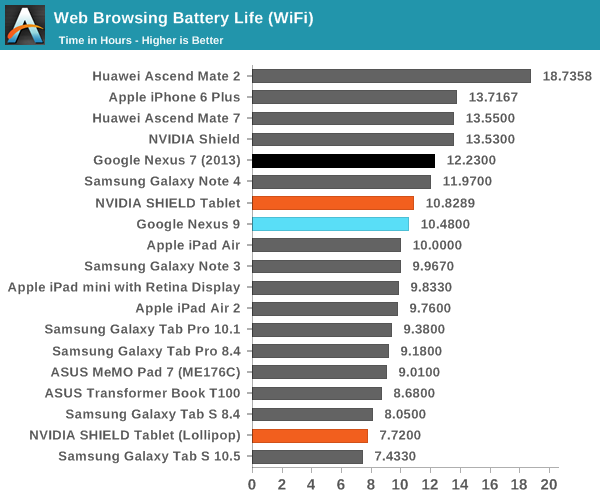
Unfortunately, the massive lead that we saw with the pure display test is significantly eroded in our web browser test. Our web test is primarily focused upon CPU, connectivity, and display efficiency. Seeing as how the Nexus 9’s display is far ahead of the iPad Air 2 and connectivity should be broadly similar in power efficiency, it seems that all of the efficiency gains from the display have gone into powering the Denver CPUs. It’s likely that process has a significant effect on this, so the more valid comparison is between SHIELD Tablet and the Nexus 9. At any rate, the Nexus 9 does manage to deliver solid battery life performance in this test which is definitely a good thing.
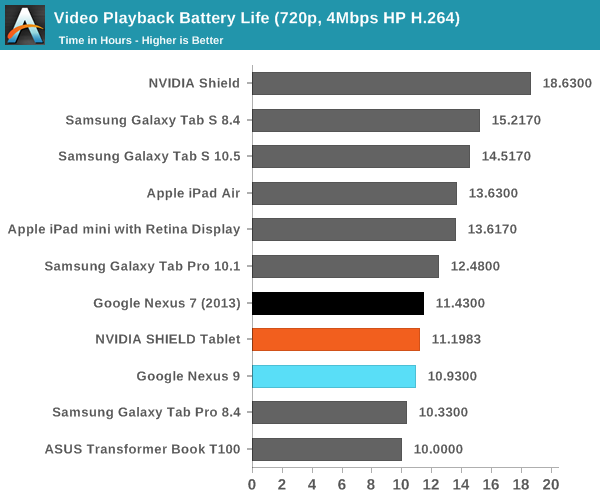
When we move to our pure video test, the Nexus 9 does have a minor regression when compared to the Nexus 7 (2013) and SHIELD Tablet. In this case, the AMOLED displays on the Galaxy Tab S line make for an easy victory due to the relatively high amount of black displayed in the content. The gap is closed between the two devices though, due to a reduced focus on SoC power.
While our web browsing test can give some idea of efficiency, there are often cases where more compute is directly used to support a better experience. To try and test for these compute-bound cases, we use Basemark OS II’s CPU battery life test and GFXBench’s T-Rex rundown for a GPU battery life test. As with the web browsing tests, these are run at 200 nits to keep things relatively equal.


In Basemark OS II, the Nexus 9 does a surprisingly good job as the CPU manages to keep incredibly high sustained performance. The large battery and efficient display seem to help to a significant extent.
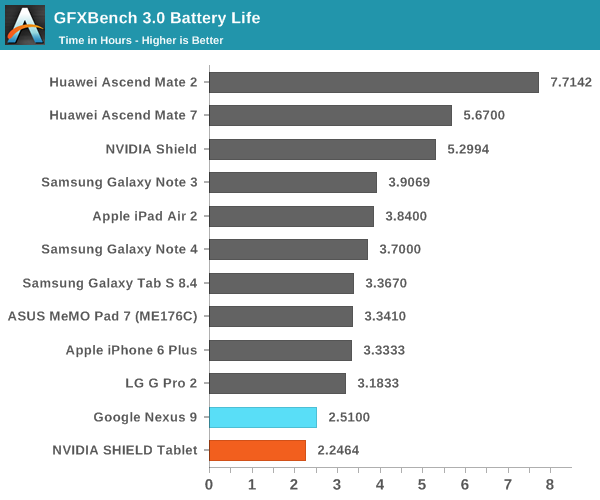
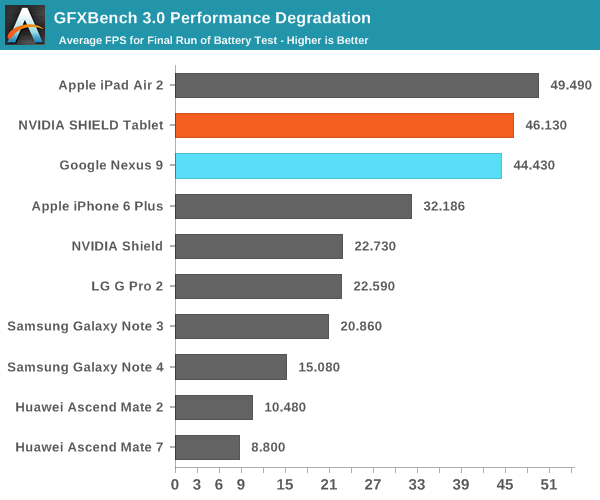
In GFXBench, it seems that not much changes overall. The GPU is definitely more power hungry than the PowerVR Series 6XT line-up and sustained performance is noticeably worse, but it’s in line with the SHIELD Tablet. End of run performance ends up a bit lower, but higher than one might expect. This is likely due to differing ambient temperatures. In practice, skin temperatures are about 45C in this test and localized to the top half of the device, and it’s likely that internal temperatures are around 80C as well. Seeing as how Tegra K1 can theoretically draw 33W in platforms such as the Jetson TK1 dev board with active cooling, it's incredibly impressive to see NVIDIA effectively keep such a powerful SoC within the constraints of a passively-cooled tablet.
Charge Time
While battery life is one part of the equation, charge time is an equally important aspect of overall battery life. To measure this, we measure the time from when charging begins to when the device reaches 100% charge. This is confirmed by taking measurements at the power outlet to make sure that power draw is below a certain level.
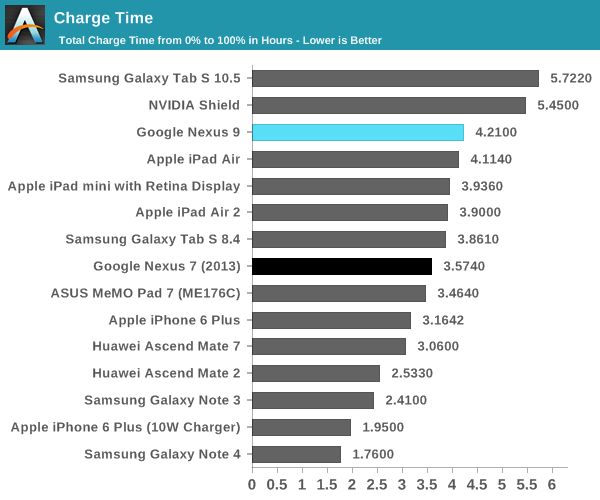
In this regard, the Nexus 9 is merely average for a tablet, although it does fall behind the competition as it uses a 5V, 1.5A charger for 7.5W instead of the 12-15W chargers that we’ve seen recently. It shouldn’t be a big issue, but in general this does mean that devices like the Galaxy Note 4 are actually better at battery life overall when compared to most tablets.










169 Comments
View All Comments
ABR - Thursday, February 5, 2015 - link
I don't know if it would change this conclusion, but load-every-15-seconds is still only testing "screenager" behavior. For example while I'm reading this comments page it's a lot longer than 15 seconds. More like 30 seconds, scroll, 30 seconds, scroll, 5-10 minutes load another. Reading e-books is another low-intensity usage. Not saying that gaming and other continuous usage patterns aren't out there, but a lot of what people say they use tablets for is lower intensity.lucam - Thursday, February 5, 2015 - link
Upspin, send your resume to Anand and write next time your article. Looking fwd to reading your pearl of wisdom...Affectionate-Bed-980 - Wednesday, February 4, 2015 - link
You guys really need to stop using that gray/black surface for the background to show off your black devices. It really makes it hard to see the details.gijames1225 - Wednesday, February 4, 2015 - link
It's a shame that NVidia couldn't get Denver out on a smaller process at launch. They're giving the A8 a run for it's money, but the 28nm process is killer at this point.WereCatf - Wednesday, February 4, 2015 - link
"it seems to be clear that an all-metal unibody design would’ve greatly improved the design of the Nexus 9 and justified its positioning better."I don't quite agree. This article mentions several times the author's wish for full-body aluminum design, but as someone who already has a tablet with a nearly full aluminum body I do have to point out that it tends to be quite slippery in one's hands; you need a much tighter grip just to hold it without it slipping and this makes it tiring to hold in the long run. A tablet with a sort of rubbery, non-slip back won't look as pretty, but it will certainly be much more comfortable and I definitely would choose practicality over looks.
danbob999 - Wednesday, February 4, 2015 - link
Also metal blocks wireless signal. Asus Transformer Prime has abysmal wifi and GPS reception because of that.There is no rational advantage to metal cases. Only looks, which is debatable.
WereCatf - Wednesday, February 4, 2015 - link
Aye, my tablet had that issue. Luckily it's easy to open up and replace the antenna with a stronger one, something that helps, but not all tablets are that easy to open or have a replaceable antenna.Impulses - Wednesday, February 4, 2015 - link
Metal would also make it heavier... Plastic doesn't have to mean back flex, it's just a design/QC issue they didn't address. My OG TF had a textured plastic back that was pretty solid, several years ago. It still creaked a little but it was mostly because of the mating of the back to the metal frame, no flex tho.olivaw - Wednesday, February 4, 2015 - link
I wonder if nVidia is "crazy enough" to develop a runtime that would JIT from android bytecode directly to denver. As it is, there are two layers of compilation going on, if ART could by swapped by an nVidia runtime things could get really interesting!joe0185 - Wednesday, February 4, 2015 - link
The browser tests are pretty worthless as it is but they are made even more worthless by the omission of version information. If AnandTech is going to include Javascript benchmarks they should at least include the browser version. What version of Chrome are you running on each device? There have been pretty dramatic improvements in Chrome on Android over the past year.